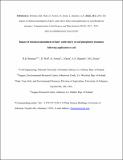| dc.contributor.author | Brennan, Raymond B. | |
| dc.contributor.author | Healy, Mark G. | |
| dc.date.accessioned | 2014-08-28T09:31:59Z | |
| dc.date.available | 2014-08-28T09:31:59Z | |
| dc.date.issued | 2014-08-22 | |
| dc.identifier.citation | Brennan, R.B., Wall, D., Fenton, O., Grant, J., Sharpley, A.N., Healy, M.G. (2014) 'The impact of chemical amendment of dairy cattle slurry before land application on soil phosphorus dynamics'. Communications In Soil Science And Plant Analysis, 45 (16):2215-2233. | en_US |
| dc.identifier.issn | 0010-3624 | |
| dc.identifier.uri | http://hdl.handle.net/10379/4515 | |
| dc.description | Journal article | en_US |
| dc.description.abstract | Application of dairy cattle slurry to agricultural soils, particularly those with high phosphorus (P) status or vulnerability to runoff, can increase P loss to waterbodies, which may accelerate eutrophication. While the effectiveness of P stabilizing amendments added to slurry or soil for reducing incidental P losses is well established, their effectiveness in reducing chronic (long-term) P losses is not as well known. Five soils (4 mineral and 1 organic) were selected to represent the range of chemical and physical properties typically found in agricultural soils in Ireland, and a 9-mo incubation study was conducted to investigate the effectiveness of amending dairy cattle slurry with either alum, lime, poly-aluminum chloride (PAC), or ferric chloride (FeCl3), in reducing water extractable P (WEP) levels in the soils. Alum, lime, and PAC were the most effective amendments in decreasing WEP (compared to a slurry-control) for the four mineral soils (up to 97% 1 mo after application and by an average of 47% at the end the 9-mo incubation period). In comparison, FeCl3 increased WEP (compared to the slurry-control) by an average of 35% at the end the study. None of the amendments examined effectively reduced WEP of the organic soil. No amendment reduced soil test P (Morgan s P (Pm) and Mehlich-3 P (M3P)) compared to the soil-only treatment. Therefore, amendment of dairy cattle slurry with alum, lime, and PAC can reduce the risk of chronic P loss in mineral soils without decreasing plant available P. Alum maintained the highest levels of M3P across the 4 mineral soils with the least risk of P loss to overlying water. With the exception of the soil-only treatment, there were significant positive relationships (p<0.05) between M3P and WEP for each treatment. Further work across a wider range of soil types and drainage regimes is required before recommendations can be made to farmers or catchment managers. | en_US |
| dc.description.sponsorship | Teagasc [Walsh Fellowship] | en_US |
| dc.format | application/pdf | en_US |
| dc.language.iso | en | en_US |
| dc.publisher | Taylor and Francis | en_US |
| dc.relation.ispartof | Communications In Soil Science And Plant Analysis | en |
| dc.rights | Attribution-NonCommercial-NoDerivs 3.0 Ireland | |
| dc.rights.uri | https://creativecommons.org/licenses/by-nc-nd/3.0/ie/ | |
| dc.subject | Alum | en_US |
| dc.subject | Lime | en_US |
| dc.subject | Management | en_US |
| dc.subject | Wastewater | en_US |
| dc.title | The impact of chemical amendment of dairy cattle slurry before land application on soil phosphorus dynamics | en_US |
| dc.type | Article | en_US |
| dc.date.updated | 2014-08-26T13:40:16Z | |
| dc.identifier.doi | 10.1080/00103624.2014.912293 | |
| dc.local.publishedsource | http://dx.doi.org/10.1080/00103624.2014.912293 | en_US |
| dc.description.peer-reviewed | peer-reviewed | |
| dc.contributor.funder | |~|Other|~| | |
| dc.internal.rssid | 6995394 | |
| dc.local.contact | Mark Healy, Dept. Of Civil Engineering, Room E210, Civil Engineering Building, Nui Galway. 5364 Email: mark.healy@nuigalway.ie | |
| dc.local.copyrightchecked | Yes | |
| dc.local.version | ACCEPTED | |
| nui.item.downloads | 413 | |


